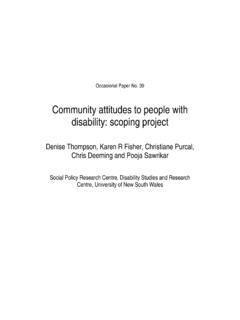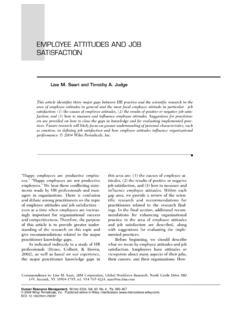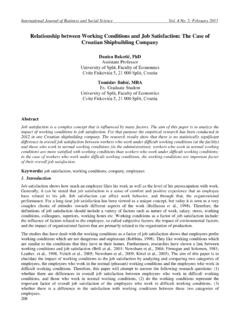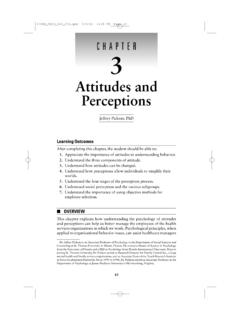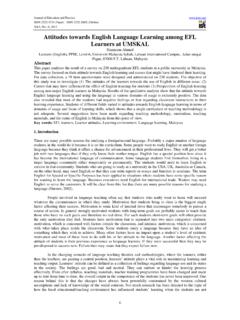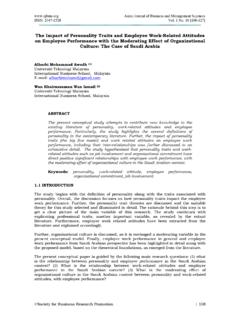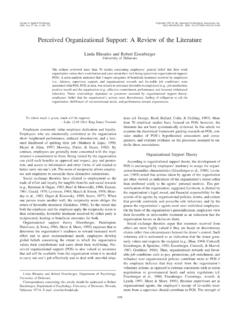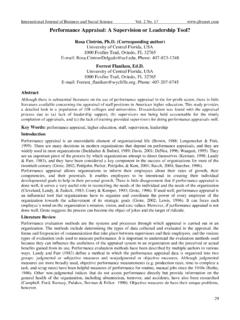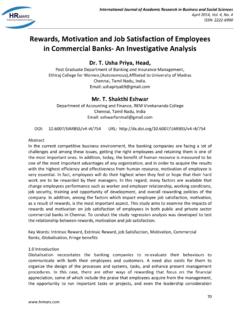Transcription of Teaching Practices, Teachers’ Beliefs and Attitudes
1 Creating Effective Teaching and Learning Environments: First Results from TALIS ISBN 978-92-64-05605-387 OECD 2009 CHAPTER 4 Teaching Practices, Teachers Beliefs and Attitudes88 Highlights89 Introduction89 Theoretical background and analytical framework92 Beliefs about the nature of Teaching and learning97 Classroom Teaching practice101 Teachers professional activities: co-operation among staff103 Classroom environment108 School-level environment: school climate111 Job-related Attitudes : self-efficacy and job satisfaction113 Understanding teachers professionalism: first steps in linking the school context and teachers Beliefs and practices to teachers perceived efficacy and the quality of the learning environment120 Conclusions and implications for policy and practiceCHAPTER 4 Teaching PRACTICES, TEACHERS Beliefs ANDATTITUDESC reating Effective Teaching and Learning Environments.
2 First Results from TALIS ISBN 978-92-64-05605-388 OECD 2009 Highlights Teachers are more inclined to regard students as active participants in the process of acquiring knowledge than to see the teacher s main role as the transmission of information and demonstration of correct solutions . This is most true in northwest Europe, Scandinavia, Australia and Korea and least true in southern Europe, Brazil and Malaysia where teachers fall between the two views. In the classroom, teachers in all countries put greater emphasis on ensuring that learning is well structured than on student-oriented activities which give them more autonomy.
3 Both of these Teaching practices are emphasised more than enhanced learning activities such as project work. This pattern is true in every country. Co-operation by teachers in all countries more commonly takes the form of exchanging and co-ordinating ideas and information than direct professional collaboration such as team Teaching . At least half of teachers in most countries spend over 80% of their lesson time on Teaching and learning. However, one in four teachers in most countries lose at least 30% of their lesson time, and some lose more than half, through disruptions and administrative tasks.
4 This is closely associated with the classroom disciplinary climate. Country and school differences in this respect are less important than differences among teachers within schools. Almost all Norwegian teachers report better than average relationships between teachers and students. In other countries, teacher-student relationships vary considerably. Only part of this variation is related to differences among schools. Even though teacher-student relations are often seen as a feature of schools as a whole, different teachers within schools perceive them differently.
5 The average levels of job satisfaction and of teachers belief in their own effectiveness are fairly similar across countries, although Norwegian teachers again stand out as well above average in both respects. Most differences in these job-related Attitudes entail differences among teachers within countries and within schools. Female teachers are less likely than male teachers to see Teaching as the direct transmission of knowledge and are more likely to adopt structuring and student oriented practices as well as to co-operate more with colleagues.
6 Teachers who undertake professional development undertake a wider array of Teaching practices and are more likely to co-operate with other teachers. 89 Teaching PRACTICES, TEACHERS Beliefs ANDATTITUDESCHAPTER 4 Creating Effective Teaching and Learning Environments: First Results from TALIS ISBN 978-92-64-05605-3 OECD 2009 INTRODUCTIONT eachers Beliefs , practices and Attitudes are important for understanding and improving educational processes. They are closely linked to teachers strategies for coping with challenges in their daily professional life and to their general well-being, and they shape students learning environment and influence student motivation and achievement.
7 Furthermore they can be expected to mediate the effects of job-related policies such as changes in curricula for teachers initial education or professional development on student learning. TALIS examines a variety of Beliefs , practices and Attitudes which previous research has shown to be relevant to the improvement and effectiveness of schools. Using representative data from 23 countries, this chapter presents a cross-cultural comparative analysis of profiles, variations and interrelationships of these aspects as they shape teachers working first part of the chapter describes teachers Beliefs , practices and Attitudes and shows that in all participating countries certain Beliefs and practices are more prominent than others.
8 It also highlights cross-cultural differences regarding Beliefs and practices, the quality of the learning environment, the strength of teachers Beliefs in their own efficacy ( self-efficacy ), and their job satisfaction. The second part of the chapter focuses on the relations between teachers views of learning and instruction and the school as their place of work. Some findings are remarkably consistent across countries. THEORETICAL BACKGROUND AND ANALYTICAL FRAMEWORK TALIS examines teachers Beliefs , Attitudes and practices and compares teachers, schools and countries.
9 Although TALIS does not seek to explain student achievement or changes in achievement, student motivation or changes in motivation, it highlights factors which have been shown to be related to student studies have described aspects of Teaching practice which are related to effective classroom learning and student outcomes (Brophy and Good, 1986; Wang, Haertel and Walberg, 1993). Close monitoring, adequate pacing and classroom management as well as clarity of presentation, well-structured lessons and informative and encouraging feedback known as key aspects of direct instruction have generally been shown to have a positive impact on student achievement.
10 This is not enough, however; while the teacher provides learning opportunities, these must be recognised and utilised by the student to be effective. Motivation, goals and outcomes have to be taken into account as well. Therefore, the framework of instructional quality is broader than the direct instruction described above. Based on results from the TIMSS video study, Klieme et al. (2006) proposed three basic (second-order) dimensions of instructional quality: clear and well-structured classroom management (which includes key components of direct instruction), student orientation (including a supportive climate and individualised instruction), and cognitive activation (including the use of deep content, higher order thinking tasks and other demanding activities).










